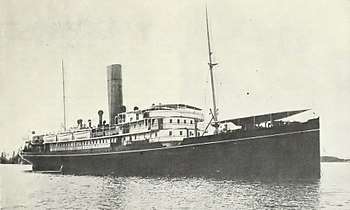HMS Osmanieh (1906)
 Osmanieh | |
| History | |
|---|---|
| Name: |
|
| Owner: | Khedivial Mail Steamship & Graving Dock Co., Ltd |
| Port of registry: |
|
| Route: | Southampton – Alexandria, Egypt |
| Builder: | Swan, Hunter & Wigham Richardson |
| Yard number: | 761 |
| Launched: | 9 May 1906 |
| Completed: | August 1906 |
| Out of service: | 31 December 1917 |
| Fate: | sunk by mines from SM UC-34 |
| Status: | wreck |
| Notes: | Registration numbers: 123690 |
| General characteristics | |
| Type: | passenger liner |
| Tonnage: | 4,041 GRT |
| Length: | 109.79 m (360.2 ft) |
| Beam: | 13.77 m (45.2 ft) |
| Installed power: | 650 NHP |
| Propulsion: | quadruple expansion steam engines |
| Speed: | 17 knots (31 km/h) |
HMS Osmanieh was a passenger and cargo ship that entered service in 1906. In 1916, the ship was requisitioned as a troopship and supply ship for the British Royal Navy in the First World War. On 31 December 1917, Osmanieh struck a mine laid by the Imperial German Naval U-boat SM UC-34 and sank at Alexandria, Egypt with the loss of 209 lives.[1][2]
The ship
The 4,041-ton steamship Osmanieh was built at the shipyard Swan, Hunter & Wigham Richardson in Wallsend and finished on 9 May 1906. The 109.79-metre (360.2 ft)-long and 13.77 metres (45.2 ft)-wide ship had a maximum draught of 7.40 meters (24.3 ft) and was equipped with quadruple expansion steam engines, which acted on two propellers and had a maximum speed of 17 knots (31 km/h) enabled. The engines were rated at 650 nominal horsepower.[3]
Osmanieh was ordered for the British-Egyptian shipping company, Khedivial Mail Steamship & Graving Dock Co., Ltd., which had offices in London and Alexandria and the ship was designed as a combined passenger and cargo ship. The company was founded in 1898 to keep ships and ports in service for the Egyptian government. However, the ships sailed under the British flag and ran between Alexandria, Constantinople, Syria and other Mediterranean ports.[3]
On 12 May 1916, Osmanieh was hired by the British Royal Navy as a Hired Transport (HT) for World War I military service and henceforth carried supplies and personnel. The ship was registered as Fleet Messenger No. 61 and received the Admiralty No. Y4.61.[3][4] On 23 June 1917 the ship evaded two torpedoes when it was attacked by a German submarine.[2]
Sinking
On 17 December 1917, Osmanieh under the command of 38-year-old Lieutenant Commander David Richard Mason with soldiers and medical personnel left Southampton and set a course for Alexandria with a stopover in the southern Italian port city of Taranto. Taranto was reached on 28 December and Alexandria on 31 December. Even before the harbour entrance, the steamer was struck amidships on the starboard side at the position 31°10′8″N 29°48′3″E / 31.16889°N 29.80083°E by a naval mine from a minefield left a few days earlier by the German submarine SM UC-34 commanded by Oberleutnant zur See Horst Obermueller.[2]
The ship sank in five to seven minutes, killing 209 people, including Lt. Commander Mason, two ship officers, 21 crew members, a Royal Navy officer, 166 other ranks and the eight nurses of Queen Alexandra's Imperial Military Nursing Service (QAIMNS).[5][2]
The day before, the troop-carrier HMT Aragon and the destroyer HMS Attack had been sunk with torpedoes at about the same spot by UC-34. 610 people died on Aragon and 10 on Attack. Some of the victims of these sinkings are buried at the Alexandria Hadra War Memorial Cemetery, where nameplates remain. However, several hundred were never found.[6]
Notes
- ↑ Helgason 2017
- 1 2 3 4 Wynn & Wynn 2017, p. 99
- 1 2 3 Letters 2017
- ↑ Tennent 2006, p. 145
- ↑ The Times 1918, p. 174
- ↑ Kindell 2011
References
- Kindell, Don (22 February 2011). "1st–31st December 1917, in date, ship/unit & name order". Royal Navy Casualty List. navalhistory.net. Retrieved 25 October 2008.
- Letters, Jan (2017). "HMS Osmanieh (Osmanich) [+1917]". wrecksite.eu. Retrieved December 31, 2017.
- Helgason, Guðmundur (2017). "Ships hit during WWI: Osmanieh". uboat.net. Retrieved November 13, 2017.
- Tennent, A. J. (2006). British Merchant Ships Sunk by U-boats in World War One. Periscope Publishing Ltd. ISBN 9781904381365. - Total pages: 258
- The Times (1918). The Times History of the War, Volume 16. The Times.
- Wynn, Stephen; Wynn, Tanya (2017). Women in the Great War. Pen & Sword Books Limited. ISBN 9781473865426. - Total pages: 152